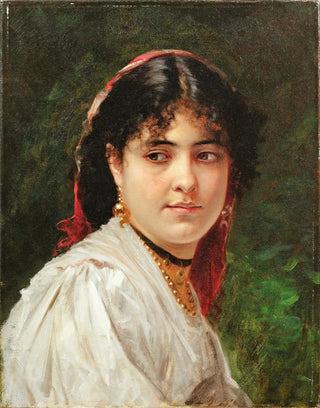Art print | Portrait of an Italian young woman - Alexandre Cabanel


View from behind

Frame (optional)
Portrait of an Italian Young Woman - Alexandre Cabanel – Captivating Introduction
The "Portrait of an Italian Young Woman" by Alexandre Cabanel is an iconic work that embodies the refinement and delicacy of the 19th-century academic movement. Created in 1874, this painting transports us to a universe where female beauty is celebrated with rare intensity. The young woman, with her gaze both mysterious and penetrating, seems to invite us to discover the secrets of her soul. Every brushstroke reveals a technical mastery that transcends a simple portrait to become a true ode to grace and elegance. In this work, Cabanel succeeds in capturing not only the appearance of his model but also the very essence of her personality, making this painting a must-see in art history.
Style and uniqueness of the work
Cabanel's style is characterized by meticulous attention to detail and a soft, harmonious color palette. In this portrait, the delicate skin tones and silky reflections of the young woman's hair are treated with virtuosity that demonstrates his technical skill. The composition is carefully balanced, highlighting the model's face while subtly integrating background elements that enhance the overall atmosphere of the work. The captivating gaze of the young woman, almost hypnotic, seems to challenge the viewer, creating an emotional connection that transcends time. This uniqueness in the representation of female beauty is one of the reasons why this work continues to enchant those who contemplate it, echoing universal and timeless emotions.
The artist and his influence
Alexandre Cabanel, born in 1823, is one of the most influential painters of his time. Raised in an artistic environment, he managed to establish himself on the Parisian scene thanks to his exceptional talent and his unique vision of beauty. His work aligns with the academic current, but he also incorporated elements of Romanticism, allowing him to create portraits of rare emotional depth. Cabanel had a prolific career, and his works were widely exhibited, attracting the attention of an audience eager for beauty and aesthetics. His ability to

Matte finish

View from behind

Frame (optional)
Portrait of an Italian Young Woman - Alexandre Cabanel – Captivating Introduction
The "Portrait of an Italian Young Woman" by Alexandre Cabanel is an iconic work that embodies the refinement and delicacy of the 19th-century academic movement. Created in 1874, this painting transports us to a universe where female beauty is celebrated with rare intensity. The young woman, with her gaze both mysterious and penetrating, seems to invite us to discover the secrets of her soul. Every brushstroke reveals a technical mastery that transcends a simple portrait to become a true ode to grace and elegance. In this work, Cabanel succeeds in capturing not only the appearance of his model but also the very essence of her personality, making this painting a must-see in art history.
Style and uniqueness of the work
Cabanel's style is characterized by meticulous attention to detail and a soft, harmonious color palette. In this portrait, the delicate skin tones and silky reflections of the young woman's hair are treated with virtuosity that demonstrates his technical skill. The composition is carefully balanced, highlighting the model's face while subtly integrating background elements that enhance the overall atmosphere of the work. The captivating gaze of the young woman, almost hypnotic, seems to challenge the viewer, creating an emotional connection that transcends time. This uniqueness in the representation of female beauty is one of the reasons why this work continues to enchant those who contemplate it, echoing universal and timeless emotions.
The artist and his influence
Alexandre Cabanel, born in 1823, is one of the most influential painters of his time. Raised in an artistic environment, he managed to establish himself on the Parisian scene thanks to his exceptional talent and his unique vision of beauty. His work aligns with the academic current, but he also incorporated elements of Romanticism, allowing him to create portraits of rare emotional depth. Cabanel had a prolific career, and his works were widely exhibited, attracting the attention of an audience eager for beauty and aesthetics. His ability to






